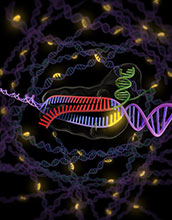Multimedia Gallery
Short DNA sequences enable bacterial enzyme to identify foreign DNA
Short DNA sequences known as "PAM" (for protospacer adjacent motif--shown in yellow) enable the bacterial enzyme Cas9 to identify and degrade foreign DNA during viral infections, as well as induce site-specific genetic changes in animal and plant cells. The presence of PAM is also required to activate the Cas9 enzyme. Cas9 plays an essential role in the bacterial immune system and is fast becoming a valuable tool for genetic engineering.
A team of researchers at Lawrence Berkeley National Lab used a combination of single-molecule imaging and bulk biochemical experiments to show how the RNA-guided Cas9 enzyme is able to locate specific 20-base-pair target sequences within genomes that are millions to billions of base pairs long.
This research was primarily supported by grants from the National Science Foundation and the National Institutes of Health.
To learn more about this research, see the Berkeley Lab news story Puzzling question in bacterial immune system answered. (Date of Image: 2012)
Credit: Illustration by KC Roeyer
Images and other media in the National Science Foundation Multimedia Gallery are available for use in print and electronic material by NSF employees, members of the media, university staff, teachers and the general public. All media in the gallery are intended for personal, educational and nonprofit/non-commercial use only.
Images credited to the National Science Foundation, a federal agency, are in the public domain. The images were created by employees of the United States Government as part of their official duties or prepared by contractors as "works for hire" for NSF. You may freely use NSF-credited images and, at your discretion, credit NSF with a "Courtesy: National Science Foundation" notation.
Additional information about general usage can be found in Conditions.
Also Available:
Download the high-resolution JPG version of the image. (6 MB)
Use your mouse to right-click (Mac users may need to Ctrl-click) the link above and choose the option that will save the file or target to your computer.



